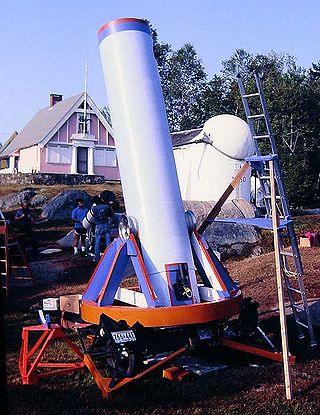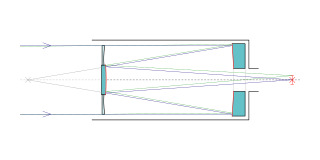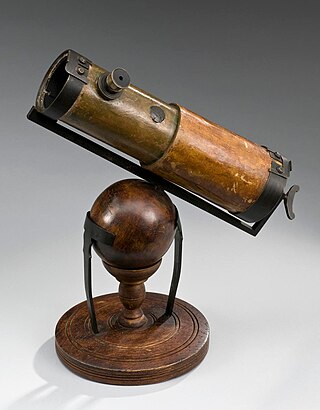
A Herschel wedge or Herschel prism is an optical prism used in solar observation to refract most of the light out of the optical path, allowing safe visual observation. It was first proposed and used by astronomer John Herschel in the 1830s.

A Herschel wedge or Herschel prism is an optical prism used in solar observation to refract most of the light out of the optical path, allowing safe visual observation. It was first proposed and used by astronomer John Herschel in the 1830s.
The prism in a Herschel wedge has a trapezoidal cross section. The surface of the prism facing the light acts as a standard diagonal mirror, reflecting a small portion of the incoming light at 90 degrees into the eyepiece. The trapezoidal prism shape refracts the remainder of the light gathered by the telescope's objective away at an angle. The Herschel wedge reflects about 4.6% of the light that passes through one of the prism faces that is flat to 1/10 of the wavelength of the light. The remaining ~95.4% of the light and heat goes into the prism and exits through the other face and out the back door of the housing; thus, the excess light and heat is disposed of and not used for observing. [1] While they decrease the intensity of the light, they do not affect the visible spectra, resulting in a more accurate spectral profile, which can be filtered to bring out certain details. They are an alternative to white light filters, which, despite their name, inherently must block certain visible spectra.[ further explanation needed ]

Hershel Wedges present a unique set of hazards and design considerations for the amateur astronomer. Unlike a full aperture ND solar filter, a sub aperture solar filter like a Herschel Wedge allows the full intensity of sunlight to be concentrated by the primary optic.
Secondary optics such as field flatteners, focal reducers, secondary mirrors, and bandpass filters, that are upstream of the Herschel wedge but downstream of the primary optic can overheat and be damaged. Reflectors are extremely dangerous to use with Herschel wedges, since their optical path is poorly contained. While many fear damaging their telescope is the primary reason for avoiding sub-aperture solar filters on reflective telescopes, blinding hazards with reflectors is perhaps even more compelling.
Unlike refractors, whose focal planes lie to the rear of the telescope, reflectors like SCT, Newtonian, RCT, Gregorian, and RASA telescopes have primary mirrors that focus light to a plane in front of the telescope. While some designs use this focal plane as is, others use additional lenses or reflective optics to both correct and move a small portion of this focal plane to a separate area on the telescope. However, it’s important to remember the majority of this focal plane remains in free space, and when it is allowed to focus unfiltered sunlight, like in the case of a Herschel Wedge telescope, it can have disastrous consequences. Looking down the front of a reflecting telescope in direct unfiltered sunlight is no different than staring into the eyepiece of a telescope aimed at the sun without a filter. The large size of reflecting primary mirrors creates the potential for this focal point to burn the inside of a telescope tube or even nearby objects in the vicinity of the telescope.
People who have made a habit of inspecting the inside of their telescope by viewing it from the front or even those who simply want to cap it while its outside may not realize that the same action during the day under sunlight will blind them. Others who use Newtonian telescopes, where a user needs to stand directly above a telescope to enjoy the eyepiece may be burned or blinded by sunlight when slewing on it in the sky.
It is also important to note that even at 4.5%, (~N.D. 1.35 [2] ) the light from the sun is still strong enough to burn the retina, and so an appropriate neutral density filter must still be used. [3]

Optics is the branch of physics that studies the behaviour and properties of light, including its interactions with matter and the construction of instruments that use or detect it. Optics usually describes the behaviour of visible, ultraviolet, and infrared light. Light is a type of electromagnetic radiation, and other forms of electromagnetic radiation such as X-rays, microwaves, and radio waves exhibit similar properties.

Amateur telescope making is the activity of building telescopes as a hobby, as opposed to being a paid professional. Amateur telescope makers build their instruments for personal enjoyment of a technical challenge, as a way to obtain an inexpensive or personally customized telescope, or as a research tool in the field of astronomy. Amateur telescope makers are usually a sub-group in the field of amateur astronomy.

A parabolicreflector is a reflective surface used to collect or project energy such as light, sound, or radio waves. Its shape is part of a circular paraboloid, that is, the surface generated by a parabola revolving around its axis. The parabolic reflector transforms an incoming plane wave travelling along the axis into a spherical wave converging toward the focus. Conversely, a spherical wave generated by a point source placed in the focus is reflected into a plane wave propagating as a collimated beam along the axis.

The history of the telescope can be traced to before the invention of the earliest known telescope, which appeared in 1608 in the Netherlands, when a patent was submitted by Hans Lippershey, an eyeglass maker. Although Lippershey did not receive his patent, news of the invention soon spread across Europe. The design of these early refracting telescopes consisted of a convex objective lens and a concave eyepiece. Galileo improved on this design the following year and applied it to astronomy. In 1611, Johannes Kepler described how a far more useful telescope could be made with a convex objective lens and a convex eyepiece lens. By 1655, astronomers such as Christiaan Huygens were building powerful but unwieldy Keplerian telescopes with compound eyepieces.

A refracting telescope is a type of optical telescope that uses a lens as its objective to form an image. The refracting telescope design was originally used in spyglasses and astronomical telescopes but is also used for long-focus camera lenses. Although large refracting telescopes were very popular in the second half of the 19th century, for most research purposes, the refracting telescope has been superseded by the reflecting telescope, which allows larger apertures. A refractor's magnification is calculated by dividing the focal length of the objective lens by that of the eyepiece.

An optical telescope is a telescope that gathers and focuses light mainly from the visible part of the electromagnetic spectrum, to create a magnified image for direct visual inspection, to make a photograph, or to collect data through electronic image sensors.

A reflecting telescope is a telescope that uses a single or a combination of curved mirrors that reflect light and form an image. The reflecting telescope was invented in the 17th century by Isaac Newton as an alternative to the refracting telescope which, at that time, was a design that suffered from severe chromatic aberration. Although reflecting telescopes produce other types of optical aberrations, it is a design that allows for very large diameter objectives. Almost all of the major telescopes used in astronomy research are reflectors. Many variant forms are in use and some employ extra optical elements to improve image quality or place the image in a mechanically advantageous position. Since reflecting telescopes use mirrors, the design is sometimes referred to as a catoptric telescope.
Optics is the branch of physics which involves the behavior and properties of light, including its interactions with matter and the construction of instruments that use or detect it. Optics usually describes the behavior of visible, ultraviolet, and infrared light. Because light is an electromagnetic wave, other forms of electromagnetic radiation such as X-rays, microwaves, and radio waves exhibit similar properties.

The Newtonian telescope, also called the Newtonian reflector or just a Newtonian, is a type of reflecting telescope invented by the English scientist Sir Isaac Newton, using a concave primary mirror and a flat diagonal secondary mirror. Newton's first reflecting telescope was completed in 1668 and is the earliest known functional reflecting telescope. The Newtonian telescope's simple design has made it very popular with amateur telescope makers.

In optics, the coma, or comatic aberration, in an optical system refers to aberration inherent to certain optical designs or due to imperfection in the lens or other components that results in off-axis point sources such as stars appearing distorted, appearing to have a tail (coma) like a comet. Specifically, coma is defined as a variation in magnification over the entrance pupil. In refractive or diffractive optical systems, especially those imaging a wide spectral range, coma can be a function of wavelength, in which case it is a form of chromatic aberration.

An eyepiece, or ocular lens, is a type of lens that is attached to a variety of optical devices such as telescopes and microscopes. It is named because it is usually the lens that is closest to the eye when someone looks through an optical device to observe an object or sample. The objective lens or mirror collects light from an object or sample and brings it to focus creating an image of the object. The eyepiece is placed near the focal point of the objective to magnify this image to the eyes. The amount of magnification depends on the focal length of the eyepiece.

A catadioptric optical system is one where refraction and reflection are combined in an optical system, usually via lenses (dioptrics) and curved mirrors (catoptrics). Catadioptric combinations are used in focusing systems such as searchlights, headlamps, early lighthouse focusing systems, optical telescopes, microscopes, and telephoto lenses. Other optical systems that use lenses and mirrors are also referred to as "catadioptric", such as surveillance catadioptric sensors.

The Schmidt–Cassegrain is a catadioptric telescope that combines a Cassegrain reflector's optical path with a Schmidt corrector plate to make a compact astronomical instrument that uses simple spherical surfaces.

The Cassegrain reflector is a combination of a primary concave mirror and a secondary convex mirror, often used in optical telescopes and radio antennas, the main characteristic being that the optical path folds back onto itself, relative to the optical system's primary mirror entrance aperture. This design puts the focal point at a convenient location behind the primary mirror and the convex secondary adds a telephoto effect creating a much longer focal length in a mechanically short system.
The Gregorian telescope is a type of reflecting telescope designed by Scottish mathematician and astronomer James Gregory in the 17th century, and first built in 1673 by Robert Hooke. James Gregory was a contemporary of Isaac Newton, and both often worked simultaneously on similar projects. Gregory's design was published in 1663 and pre-dates the first practical reflecting telescope, the Newtonian telescope, built by Sir Isaac Newton in 1668. However, Gregory's design was only a theoretical description, and he never actually constructed the telescope. It was not successfully built until five years after Newton's first reflecting telescope.

A star diagonal, erecting lens or diagonal mirror is an angled mirror or prism used in telescopes that allows viewing from a direction that is perpendicular to the usual eyepiece axis. It allows more convenient and comfortable viewing when the telescope is pointed at, or near the zenith. Also, the resulting image is right side up, but is reversed from left to right.

The first reflecting telescope built by Sir Isaac Newton in 1668 is a landmark in the history of telescopes, being the first known successful reflecting telescope. It was the prototype for a design that later came to be called the Newtonian telescope. There were some early prototypes and also modern replicas of this design.
In optics, a relay lens is a lens or a group of lenses that receives the image from the objective lens and relays it to the eyepiece. Relay lenses are found in refracting telescopes, endoscopes, and periscopes to optically manipulate the light path, extend the length of the whole optical system, and usually serve the purpose of inverting the image. They may be made of one or more conventional lenses or achromatic doublets, or a long cylindrical gradient-index of refraction lens.